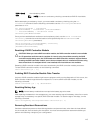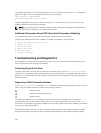
Reconstructing A Physical Disk
If two or more physical disks in a disk group have failed, the virtual disk shows a status of Failed. All of the
virtual disks in the disk group are no longer operating. To return the disk group to an Optimal status, you
must replace the failed physical disks. After replacing the physical disks, reconstruct the data on physical
disks. The reconstructed data is the data as it would appear on the failed physical disks.
To reconstruct a physical disk, run the following command:
start physicalDisk [enclosureID,slotID] reconstruct
where, enclosureID and slotID are the identifiers for the physical disk.
NOTE: You can use this command only when the physical disk is assigned to a RAID 1, 5, or 6 disk
group.
Initializing A Virtual Disk
CAUTION: When you initialize a virtual disk, all data on the virtual disk and all information about
the virtual disk are erased.
A virtual disk is automatically initialized when you first create it. If the virtual disk starts exhibiting failures,
you might be required to re-initialize the virtual disk to correct the failure condition.
The initialization process cannot be cancelled once it has begun. This option cannot be used if any
modification operations are in progress on the virtual disk or disk group. To initialize a virtual disk, run the
following command:
start virtualDisk [virtualDiskName] initialize
where, virtualDiskName is the identifier for the virtual disk.
NOTE: Initializing a thin virtual disk may take an extremely long time.
Redistributing Virtual Disks
Redistributing virtual disks returns the virtual disks to their preferred RAID controller module owners. The
preferred RAID controller module ownership of a virtual disk or disk group is the RAID controller module
of an active-active pair that is designated to own the virtual disks. The preferred owner for a virtual disk is
initially designated when the virtual disk is created. If the preferred RAID controller module is being
replaced or undergoing a firmware download, ownership of the virtual disks is automatically shifted to
the second RAID controller module. The second RAID controller module becomes the current owner of
the virtual disks. This change is considered to be a routine ownership change and is reported in the MEL.
CAUTION: Ensure that a multipath driver is installed, or the virtual disks are not accessible.
To redistribute virtual disks to their preferred RAID controller modules, run the following command:
reset storageArray virtualDiskDistribution
NOTE: You cannot run this command if all virtual disks are currently owned by their preferred RAID
controller module or if the storage array does not have defined virtual disks.
Under some host operating systems, you must reconfigure the multipath host driver. You might also need
to make operating system modifications to recognize the new I/O path to the virtual disk.
121


















